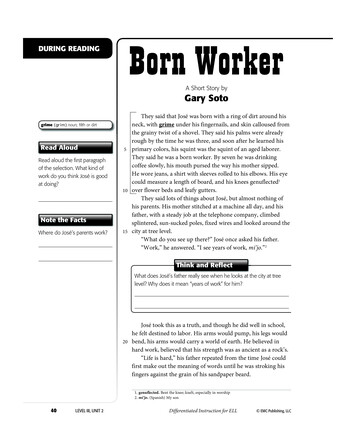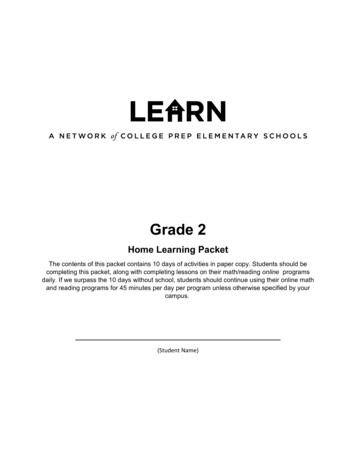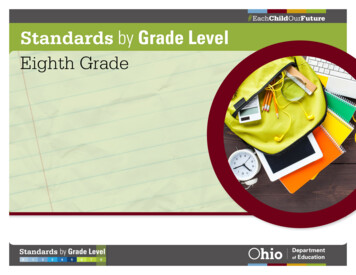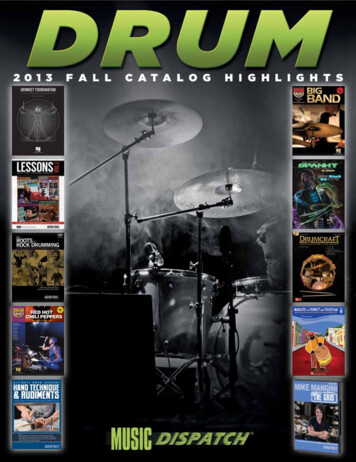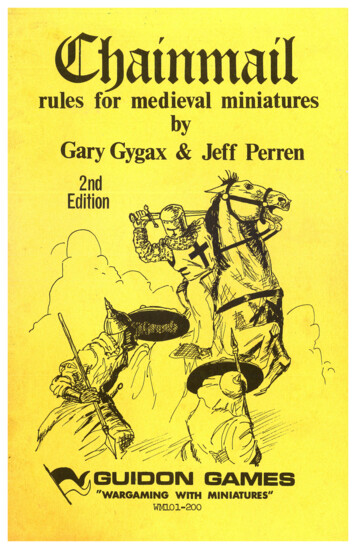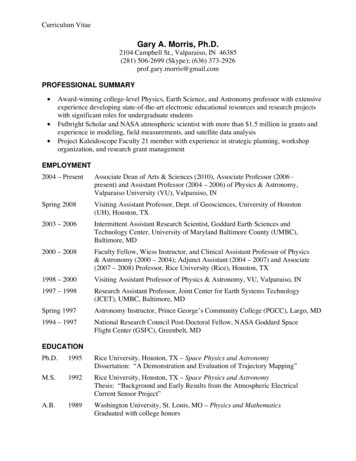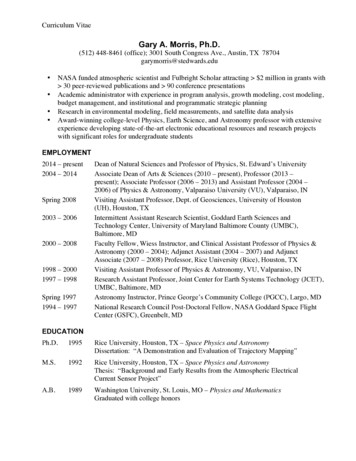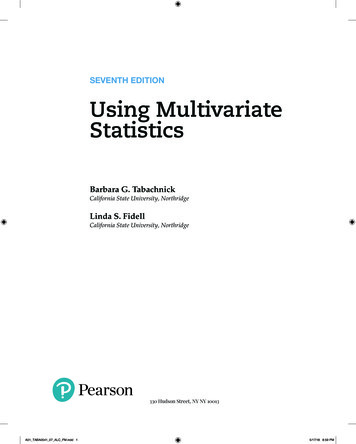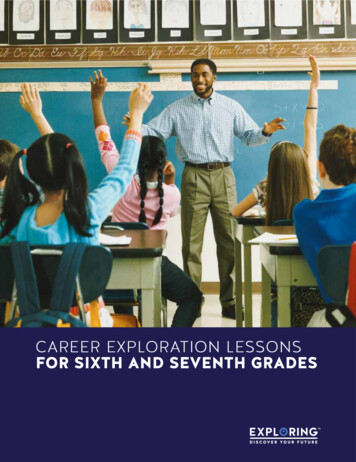
Transcription
7th Grade Narrative Unit“Seventh Grade” by Gary Soto1.2.3.4.5.6.7.8.9.10.11.12.13.On the first day of school, Victor stood in line half an hour before he came to awobbly card table. He was handed a packet of papers and a computer card on which he listed hisone elective1, French. He already spoke Spanish and English, but he thought some day he mighttravel to France, where it was cool; not like Fresno, where summer days reached 110 degrees inthe shade. There were rivers in France, and huge churches, and fair-skinned people everywhere,the way there were brown people all around VictorBesides, Teresa, a girl he had liked since they were in catechism classes at Saint Theresa’s,was taking French, too. With any luck they would be in the same class. Teresa is going to be mygirl this year, he promised himself as he left the gym full of students in their new fall clothes.She was cute. And good in math, too, Victor thought as he walked down the hall to hishomeroom. He ran into his friend, Michael Torres, by the water fountain that never turned off.They shook hands, raza-style, and jerked their heads at one another in a saludo de vato2.“How come you’re making a face?” asked Victor.“I ain’t making a face, ese3. This is my face.” Michael said his face had changed during thesummer. He had read a GQ magazine that his older brother had borrowed from the Book Mobileand noticed that the male models all had the same look on their faces. They would stand, onearm around a beautiful woman, and scowl. They would sit at the pool, their rippled stomachsdark with shadow, and scowl. They would sit at dinner tables, cool drinks in their hands, andscowl.“I think it works,” Michael said. He scowled and let his upper lip quiver. His teeth showedalong with the ferocity of his soul. “Belinda Reyes walked by a while ago and looked at me,” hesaid.Victor didn’t say anything, though he thought his friend looked pretty strange. They talkedabout recent movies, baseball, their parents, and the horrors of picking grapes in order to buytheir fall clothes. Picking grapes was like living in Siberia4, except hot and more boring.“What classes are you taking?” Michael said, scowling.“French. How ‘bout you?”“Spanish. I ain’t so good at it, even if I’m Mexican."“I’m not either, but I’m better at it than math, that’s for sure.”A tinny, three-beat bell propelled students to their homerooms. The two friends socked eachother in the arm and went their ways, Victor thinking, man, that’s weird. Michael thinks makinga face makes him handsome.On the way to his homeroom, Victor tried a scowl. He felt foolish, until out of the corner ofhis eye he saw a girl looking at him. Umm, he thought, maybe it does work. He scowled withgreater conviction5.In the homeroom, roll was taken, emergency cards were passed out, and they were given abulletin to take home to their parents. The principal, Mr. Belton, spoke over the cracklingloudspeaker, welcoming the students to a new year, new experiences, and new friendships. Thestudents squirmed in their chairs and ignored him, they were anxious to go to first period. Victorsat calmly, thinking of Teresa, who sat two rows away, reading a paperback novel. This would1elective (n.) - optional course or subjectraza-style. . .saludo de vato - Spanish gestures of greeting between friends3ese - Spanish word for “man”4Sibera - region in northern Asia known for its harsh winters5conviction (n.) - belief2SDUSD Mid-level Units of Study 8/9/07
7th Grade Narrative 9.30.31.32.33.34.be his lucky year. She was in his homeroom, and would probably be in his English and mathclasses. And, of course, French.The bell rang for first period, and the students herded noisily through the door. Only Teresalingered, talking with the homeroom teacher.“So you think I should talk to Mrs. Gaines?” she asked the teacher. “She would know aboutballet?”“She would be a good bet,” the teacher said. Then added, “Or the gym teacher, Mrs. Garza."Victor lingered, keeping his head down and staring at his desk. He wanted to leave when shedid so he could bump into her and say something clever.He watched her on the sly. As she turned to leave, he stood up and hurried to the door,where he managed to catch her eye. She smiled and said, “Hi, Victor."He smiled back and said, “Yeah, that's me.” His brown face blushed. Why hadn’t he said,“Hi, Teresa,” or "How was your summer?” or something nice.As Teresa walked down the hall, Victor walked the other way, looking back, admiring howgracefully she walked, one foot in front of the other. So much for being in the same class, hethought. As he trudged to English, he practiced scowling.In English they reviewed the parts of speech. Mr. Lucas, a portly man, waddled down theaisle, asking, “What is a noun?”“A person, place, or thing,” said the class in unison.“Yes, now somebody give mean example of a person--you, Victor Rodriguez.”"Teresa,” Victor said automatically. Some of the girls giggled. They knew he had a crush onTeresa. He felt himself blushing again.“Correct,” Mr. Lucas said. “Now provide me with a place.”Mr. Lucas called on a freckled kid who answered, “Teresa’s house with a kitchen full of bigbrothers.”After English, Victor had math, his weakest subject. He sat in the back by the window,hoping that he would not be called on. Victor understood most of the problems, but some of thestuff looked like the teacher made it up as she went along. It was confusing, like the inside of awatch.After math he had a fifteen-minute break, then social studies, and finally lunch. He bought atuna casserole with buttered rolls, some fruit cocktail, and milk. He sat with Michael, whopracticed scowling between bites.Girls walked by and looked at him, “See what I mean, Vic?” Michael scowled. “They loveit.”“Yeah, I guess so.”They ate slowly, Victor scanning the horizon for a glimpse of Teresa. He didn’t see her. Shemust have brought lunch, he thought, and is eating outside. Victor scraped his plate and leftMichael, who was busy scowling at a girl two tables away.The small, triangle-shaped campus bustled with students talking about their new classes.Everyone was in a sunny mood. Victor hurried to the bag lunch area, where he sat down andopened his math book. He moved his lips as if he were reading, but his mind was somewhereelse. He raised his eyes slowly and looked around. No Teresa.He lowered his eyes, pretending to study, then looked slowly to the left. No Teresa. Heturned a page in the book and stared at some math problems that scared him because he knew hewould have to do them eventually. He looked at the right. Still no sign of her. He stretched outlazily in an attempt to disguise his snooping.Then he saw her. She was sitting with a girlfriend under a plum tree. Victor moved to a tablenear her and daydreamed about taking her to a movie. When the bell sounded, Teresa looked up,SDUSD Mid-level Units of Study 8/9/07
7th Grade Narrative 0.51.52.53.54.55.56.and their eyes met. She smiled sweetly and gathered her books. Her next class was French, sameas Victor’s.They were among the last students to arrive in class, so all the good desks in the back hadalready been taken. Victor was forced to sit near the front, a few desks away from Teresa, whileMr. Bueller wrote French words on the chalkboard. The bell rang, and Mr. Bueller wiped hishands, turned to the class, and said, “Bonjour.”6“Bonjour,” braved a few students.“Bonjour,” Victor whispered. He wondered if Teresa heard him.Mr. Bueller said that if the students studied hard, at the end of the year they could go toFrance and be understood by the populace.One kid raised his hand and asked, “What’s ‘populace’?”“The people, the people of France.”Mr. Bueller asked if anyone knew French. Victor raised his hand, wanting to impressTeresa. The teacher beamed and said, “Très bien. Parlez-vous français?”7Victor didn’t know what to say. The teacher wet his lips and asked something else inFrench. The room grew silent. Victor felt all eyes staring at him. He tried to bluff his way out bymaking noises that sounded French.“La me vave me con le grandma,” he said uncertainly.Mr. Bueller, wrinkling his face in curiosity, asked him to speak up.Great rosebushes of red bloomed on Victor’s cheeks. A river of nervous sweat ran down hispalms. He felt awful. Teresa sat a few desks away, no doubt thinking he was a fool. Withoutlooking at Mr. Bueller, Victor mumbled, ‘Frenchie oh wewe gee in September.”Mr. Bueller asked Victor to repeat what he said.“Frenchie oh wewe gee in September," Victor repeated.Mr. Bueller understood that the boy didn’t know French and turned away. He walked to theblackboard and pointed to the words on the board with his steel-edged ruler.“Le bateau,” he sang.“Le bateau,” the students repeated.“Le bateau est sur l’eau,”8 he sang.“Le bateau est sur l’eau.”Victor was too weak from failure to join the class. He stared at the board and wished he hadtaken Spanish, not French. Better yet, he wished he could start his life over. He had never beenso embarrassed. He bit his thumb until he tore off a sliver of skin.The bell sounded for fifth period, and Victor shot out of the room, avoiding the stares of theother kids, but had to return for his math book. He looked sheepishly9 at the teacher, who waserasing the board, then widened his eyes in terror at Teresa who stood in front of him. “I didn’tknow you knew French,”she said. “That was good.”Mr. Bueller looked at Victor, and Victor looked back. Oh please, don’t say anything, Victorpleaded with his eyes. I’ll wash your car, mow your lawn, walk your dog--anything! I'll be yourbest student, and I’ll clean your erasers after school.Mr. Bueller shuffled through the papers on his desk, He smiled and hummed as he sat downto work. He remembered his college years when he dated a girlfriend in borrowed cars. She6Bonjour – French for “Hello”; “Good day”Très bien. Parlez-vous français? – French for “Very well. Do you speak French?”8Le bateau est sur l’eau – French for “The boat is on the water.”9Sheepishly (adv.) – in a shy or embarrassed way7SDUSD Mid-level Units of Study 8/9/07
7th Grade Narrative Unit57.58.59.60.61.62.63.64.thought he was rich because each time he picked her up he had a different car. It was fun untilhe had spent all his money on her and had to write home to his parents because he was broke.Victor couldn’t stand to look at Teresa. He was sweaty with shame. “Yeah, well, I picked upa few things from movies and books and stuff like that.” They left the class together. Teresaasked him if he would help her with her French.“Sure, anytime,” Victor said.“I won’t be bothering you, will I?”“Oh no, I like being bothered.”“Bonjour.” Teresa said, leaving him outside her next class. She smiled and pushed wisps ofhair from her face.“Yeah, right, bonjour,” Victor said. He turned and headed to his class. The rosebuds ofshame on his face became bouquets of love. Teresa is a great girl, he thought. And Mr. Buelleris a good guy.He raced to metal shop. After metal shop there was biology, and after biology a long sprintto the public library, where he checked out three French textbooks.He was going to like seventh grade.GARY SOTO(b. 1952)Gary Soto has a lot in common with the character Victor Rodriguez. Soto grew up inFresno and once harvested crops in the fields of California.Soto began writing while in college. In the fiction and poetry he’s written since, hereaches back to the sense of belonging he felt in Fresno. He often writes for youngadults, who he knows are also searching for their own community and their ownplace.SDUSD Mid-level Units of Study 8/9/07
7th Grade Narrative UnitDiagnostic Assessment- Student CopyNarrative Diagnostic AssessmentText: “Seventh Grade” by Gary Soto1. “Seventh Grade” is a narrative. How is this form of writing different from a persuasive text?2. Read paragraphs 7-10 (a) Who is speaking? (b) How do you know?3. What is the theme of the story? Why do you think so?4. Analyze a character. How do his/her words and actions influence the thoughts and/oractions of another character?5. What is the author’s attitude towards Mr. Bueller as shown through his words and actions?6. This story is told from whose point of view? Why would the author choose to tell this storyusing this point of view?7. How does the author show the readers how much Victor likes Theresa? Use evidence fromthe text to support your answer.8. What main literacy devices does the author use to give insight into the characters andadvance? Provide evidence from the text to support your answer?9. In paragraph #62, the author says, “The rosebuds of shame on his face became bouquets oflove.” What are the actions that led to this change of feeling in Victor?10. Read paragraph #18. The author says that Victor managed to “catch her eye.”What is the meaning of this idiom?11. Read paragraph #54. What does the underlined word, sheepishly, mean? How do you know?SDCS Mid-level Units of Study 8/9/07
7th Grade Narrative UnitSDCS Mid-level Units of Study 8/9/07Diagnostic Assessment- Student Copy
7th Grade Narrative UnitDiagnostic Assessment- Teacher CopyNarrative Diagnostic AssessmentText: “Seventh Grade” by Gary Soto1. “Seventh Grade” is a narrative. How is this form of writing different from a persuasive text?(RL 3.1) (M-B)A narrative is different from a persuasive text because the narrative combines story elementsrelated to a controlling idea to reveal a thought-provoking theme. Story elements are interwoventogether to advance the plot. The narrative includes an exposition, a rising action that leads toone or more conflicts that are resolved and may or may not have a denouement. IN contrast, thepersuasive text states a clear position/thesis that uses logical and well-articulated anddocumented evidence to support the position/thesis. The persuasive composition addressesopposing viewpoints and provides counterarguments.2. Read lines 7-10. (a) Who is speaking? (b) How do you know? (M-C)(a) Michael and Victor are having a conversation.(b) Each time a new person speaks, a new paragraph is created.The two characters, Michael and Victor, are questioning each other. That issignaled by the language, such as, “How about you?” and “I’m not either.”3. What is the theme of the story? Why do you think so? (RL 3.4) (M-E) * Answers will varyPossible theme: Taking risks can lead you to your goals. Victor has a desire to go beyond his boundaries. He wants to leave Fresno and supports the desireto go to France by taking French. He also a strong desire to date Teresa so takes some chances totry to impress her. He attempts to speak French and fails. But instead of giving up, he goes to thelibrary to check out 3 French books. He is being proactive, working towards both his goals –going to France and dating Teresa.4. Analyze a character. How do his/her words and actions influence the thoughts and/or actions of anothercharacter? (RL 3.3) (M-F) Mr. Bueller chooses not to humiliate Victor, even though he knows Victor is pretending to speakFrench. Based on these kind actions, Victor is relieved and considers Mr. Bueller to be “a goodguy.” Mr. Bueller’s kindness has a positive effect on Victor, who becomes motivated to do well inFrench.Victor takes the opportunity of being in French class with Teresa to impress her by trying tospeak French. Even though Victor feels like a fool for not being able to convince Mr. Bueller thathe is speaking French, Teresa is impressed and begins a conversation with him, leading the readerto anticipate Teresa likes Victor and wants to spend time with him on a regular basis.Teresa is a person that appears to be very conscientious student. Her scholarly actions influencedthe way Victor acted in school. She is good in math, she stays after class to talk to the teachers,and she reads books during homeroom. She doesn’t seem to worry about other kids calling her a“schoolgirl”. Victor is very interested in dating Teresa, and so begins to emulate some of herscholarly tendencies. He sat quietly during homeroom instead of squirming in his chair like theother kids. During lunchtime, he pretended to be quietly reading his math book instead ofplaying around with the other boys. Victor also took a risk by taking a French class, which wasout of his comfort zone in order to impress Teresa with his French language knowledge.Mid-level Units of Study 8/9/07
7th Grade Narrative UnitDiagnostic Assessment- Teacher Copy5. What is the author’s attitude towards Mr. Bueller as shown through his words and actions? (RL 3.2) (M-F) The author portrays Mr. Bueller as “a good guy.” We know this because of his reaction toVictor’s actions in French class. He shows understanding and empathy for his student who findshimself in an embarrassing situation, while trying to impress a girl he especially likes. GarySoto’s attitude toward Mr. Bueller reflects his own comfortable memories with teachers inFresno.6. This story is told from whose point of view? Why would the author choose to tell this story using thispoint of view? (M-G)The story is told in the 3rd person omniscient point of view. By telling the story this way theauthor allows us to know the thoughts and actions of all the characters. It is through theinteraction of all the characters that the plot moves along and we come to understand the meaningof the story, which reveals the theme.7. How does the author show the readers how much Victor likes Theresa? Use evidence from the text tosupport your answer. (M-H) (RL 3.3) Paragraph 2 – He liked Teresa since they were in catechism together. Paragraph 13- In his homeroom class, Victor sat calmly thinking about Teresa. Paragraph 17- He wanted to leave class when she did. Paragraph 20 – He admired how gracefully she walked Paragraph 24 – He blushed when the girls giggled because they knew he had a crush on Teresa. In French class, he does something foolish to impress her. Paragraph 34 – Victor moved to a table near her and dreamed of taking her to a movie. In the end – he says Teresa is a great girl and she was going to enjoy seventh grade.8. What literary devices does the author use to give insight into the characters and advance the plot? Provideevidence from the text to support your answer. (M-I) (RL 3.3) The author uses figurative language, such as idioms, as in paragraph #3, “How come you’remaking a face?” He also uses descriptive language, such as “Great rosebushes of red bloomed on Victor’s cheeks.” The author primarily uses dialogue, which moves the plot and helps the reader get to know thecharacters and their relationship to each other. For example, the conversation in class when Mr.Lucas says, “Yes, now somebody give me an example of a person – you, Victor.” And Victor, says,“Teresa.” Then the girls giggled.9. In paragraph #62, the author says, “The rosebuds of shame on his face became bouquets of love.”What are the actions that led to this change of feeling in Victor? (M-J) (RL 3.2)Victor took a risk and attempted to speak French and, although he failed to say the correctanswer in class, Mr. Bueller did not point out his mistake, and Teresa was still impressed. Afterclass she said, “I didn’t know you knew French,” and once again, Mr. Bueller didn’t acknowledgeVictor’s mistake. Then Teresa asked him if he would help her with French. So “the rosebuds ofshame” that came with his embarrassment in class, turned to “bouquets of love” for Teresa.10. Read paragraph #18. The author says that Victor managed to “catch her eye.” What is the meaning ofthis idiom? (M-K) (RW 1.1)In this context the phrase means he managed to “get her attention.”11. Read paragraph #54. What does the underlined word, sheepishly, mean? How do you know? (M-K) (RW 1.3)Victor looked sheepishly, meaning he was embarrassed. I know this because Victorywas in a hurry to get out of the room because he didn’t know French and felt ashamedMid-level Units of Study 8/9/07
7th Grade Narrative Unitand not very confident.Mid-level Units of Study 8/9/07Diagnostic Assessment- Teacher Copy
7th Grade Persuasive UnitDiagnostic Assessment – Teacher CopyDiagnostic Assessment AnswersText: “Is 16 Too Young to Drive?”ANSWER QUESTION #1 AND #2 BEFORE READING THE TEXT.1. This is persuasive text from a magazine. How is a persuasive text different from a narrative?(RC 2.1) (M-B)A persuasive text is a nonfiction text that argues a point with the purpose ofchanging the audience’s opinion or calling the audience to action. It states thewriter’s position on an issue and gives supporting evidence, using facts andexamples. A persuasive text addresses readers' concerns and givescounterarguments.A narrative can be fiction or nonfiction and has story elements – plot, theme,characters, setting, and point of view. The purpose of a narrative, or story, is toinform and to entertain. A good story has conflict and follows an organizationalpattern that includes an exposition, rising action, falling action, a resolution, anddenouement. Conflict and events are usually told in chronological order withliterary devices that help to make the story come alive.2. Look at the text features. What do you think this text will be about? How do you know?(M-A) The title and subtitle on the first page let me know the article will be about thedriving age and whether or not 16 year olds should drive, since they are morelikely to crash.The yes and no comments make me think that both sides of the debate will beaddressed.Evidence, such as statistics, will support the dangerous risks of teenage driving.I can tell by reading the caption on page 12 and the graphs on page 13.The sidebar story called “Reckless and Fatal” also tells me the article will beabout the dangers connected to teenage driving.READ THE RUNNING TEXT AND ANSWER THE FOLLOWING QUESTIONS.3. What is the main idea of this article? Use evidence from the text to support your answer.(M-E) Driving requires maturity and experience that 16 year olds do not possess, so thelaws need to be stronger to keep them safe.Since teens behind the wheel are more likely than adults to crash, speed and takedangerous risks, there is reason to believe that there should be drivingrestrictions for 16 year olds.I know this because the author lists statistics about teen drivers on the last pageand quotes several experts like Irving Slosberg and Allan Williams.I know this because of the statistical chart on page 13 called “Safe at the Wheel”and the quotes on the first and third paragraph on page 12.SDCS Mid-Level Units of Study 8/9/07
7th Grade Persuasive UnitDiagnostic Assessment – Teacher Copy4. Read page 12 paragraph 6. What is the topic sentence? How do you know? (M-C) Slosberg has a special interest in keeping teens safe on the road.I know this because all of the other sentences in the paragraph relate back to thismain idea.The paragraph goes on to explain that his 14-year-old daughter was killed in acrash. That is his special interest mentioned in the topic sentence.5. How does the subheading, Personal Responsibility, relate to the article? (M-D) Drivers should wear seatbelts.Teenage drivers should drive safely, not recklessly.The article talks about your responsibility while driving.When teens are at the wheel, it is their responsibility to follow the rules and keepthemselves and everyone around them safe.Teenage drivers with two or more passengers have an increased risk of crashingso they need to make better decisions.6. What is the author’s perspective on this issue? (RC 2.4) (M-G) Stronger restrictions and training requirements are needed for 16-year-olddrivers.The author believes that 16-year-olds are too young to drive and needrestrictions.7. Where in the text does the author address opposing viewpoints/counterarguments? (M-F) Page 10 – The Yes and No responses on the first page address both viewpoints byoffering opinions by teenagers.Page 12 – The author states: “Most teens seem to think like Sabina. They believeit’s not logical to assume keeping 16-year-olds off the road will savelives.”Page 12 – A quote from another teenager: “Whatever the first year of driving is,whether it’s 16 or 22, it’s still the first year.”Page 12 – Allan Williams says, “There is no magic age.”Page 13 – The downside of such graduated licensing rules, according to experts,is that they are hard to enforce and are often ignored.SDCS Mid-Level Units of Study 8/9/07
7th Grade Persuasive UnitDiagnostic Assessment – Teacher Copy8. What persuasive techniques does the author use to convince the reader? Use textual evidenceto support your answer. (M-H) Appeals to emotion through word choice and strong language– “It may send chills down your spine to learn that many scientists andlawmakers are siding with Leanne, not Maggie.”– Subheading – “Reckless and Fatal”Appeals to emotion through personal anecdotes– Tells story of Irving Solsberg’s daughter who was killed in a car crash– Maggie tells of personal experience of driving with kids in the car– Story of Kelly Pennings, the only survivor in a car crashAppeals to reason through statistics, facts and quotations– Statistics on the graph on page 13, such as 937 16-year-old drivers wereinvolved in fatal crashes in 2003– Statistics in the running text, such as 42 out of 52 states have institutedgraduated licensingAppeals to character through expert opinions– Irving Slosberg, Florida state legislator, states on page 12, that NewJersey’s fatality rate is lower because you have to be 17 to get a drivers’license.– Allan Williams, of the Insurance Institute for Highway Safety, states onpage 12: “For a 16-year-old with one passenger, the risk of crashing isone-and-a-half times what it is driving alone.”The yes and no debate on the front page quotes two teens9. Is there evidence of bias or stereotyping? Explain your thinking. (RC 2.6) (M-I)The author has a bias. Although he presents some opposing viewpoints, his statisticsand the quotes from experts are biased against teen drivers and tend to favor theidea of having restrictions. The article stereotypes all teens as reckless drivers.10. Identify three of the author’s strongest arguments. Explain your thinking. (M-J) The author states some alarming statistics on page 13. For example, he says,“77% of 16-year-olds’ fatal crashes involve driver error.” This is a hugenumber and it makes you think you are more likely to have a fatal crash thannot.The author gives some personal anecdotes. For example, Slosberg’s daughter,Dori, wasn’t wearing a seatbelt and the car was overcrowded. She died.Personal stories like this tug at your emotions and have a strong impact.The article states that graduated licensing in 42 states has led to fewer teensbeing killed in car accidents. Even though this is hard to enforce, it does showthat kids need practice and gradual release before driving with passengers.SDCS Mid-Level Units of Study 8/9/07
7th Grade Persuasive UnitDiagnostic Assessment – Teacher Copy11. Read page 12 paragraph 2. What does the underlined word, instituted, mean? How do youknow? (RW 1.3) (M-K)Set in motion or establish. I know it is a verb by the word’s position in the sentence.I could tell by reading the paragraph that it is something the states are doing.12. Look at the graph at the top of page 13. What does the underlined word, misjudging, mean?How do you know? (RW 1.2) (M-L) Mis is a prefix that means “not,” “bad” or “unsuitable.”Judge is a root word that means to form an opinion or evaluate something.So misjudge means to form a bad, wrong or unsuitable opinion or to judgesomething incorrectly.SDCS Mid-Level Units of Study 8/9/07
7th Grade Persuasive UnitNameDiagnostic Assessment – Student CopyPeriodDateDiagnostic AssessmentText: “Is 16 Too Young to Drive?”ANSWER QUESTION #1 AND #2 BEFORE READING THE TEXT.1. This is persuasive text from a magazine. How is a persuasive text different from anarrative?2. Look at the text features. What do you think this text will be about? How do youknow?READ THE RUNNING TEXT AND ANSWER THE FOLLOWING QUESTIONS.3. What is the main idea of this article? Use evidence from the text to support youranswer.4. Read page 12 paragraph 6. What is the topic sentence? How do you know?5. How does the subheading, Personal Responsibility, relate to the article?6. What is the author’s perspective on this issue?7. Where in the text does the author address opposing viewpoints/counterarguments?8. What persuasive techniques does the author use to convince the reader? Use textualevidence to support your answer.9. Is there evidence of bias or stereotyping? Explain your thinking.10. Identify three of the author’s strongest arguments. Explain your thinking.11. Read page 12 paragraph 2. What does the underlined word, instituted, mean?How do you know?12. Look at the graph at the top of page 13. What does the underlined word, misjudging,mean? How do you know?SDCS Mid-level Units of Study 8/9/07
7th Grade Expository UnitDiagnostic Assessment – Teacher CopyDiagnostic Assessment AnswersText: “Poverty in America”ANSWER QUESTION #1 AND #2 BEFORE READING THE TEXT1. This is an expository article from a news magazine. How is an expository text differentfrom a narrative text? (RC 2.1) (M-B) These are nonfiction articles that present factual information, explainingsomething that is happening in our world today. They contain text features suchas pictures, graphs, timelines, and subtitles. The paragraphs work together toreveal a main idea and the details that support the main idea. Expository textsare researched-based.A narrative, on the other hand, can be fiction or nonfiction. It is told in asequential manner with a beginning, middle and end and the story elementscombine to reflect a theme.2. Looking at all the text features, what do you predict this text will be about? How do youknow? (M-A) This will be about the growing poverty in the United States bec
3 ese - Spanish word for “man” 4 Sibera - region in northern Asia known for its harsh winters 5 conviction (n.) - belief . 7th Grade Narrative Unit SDUSD Mid-level Units of Study 8/9/07 be his lucky year. She was in his homeroom, and would probably be
